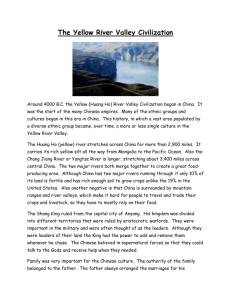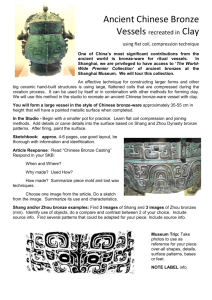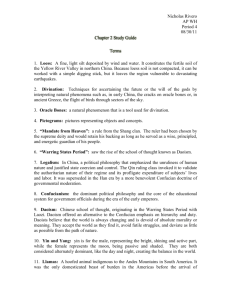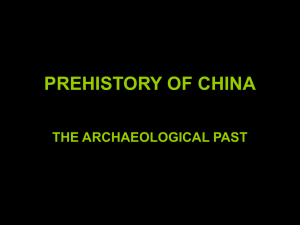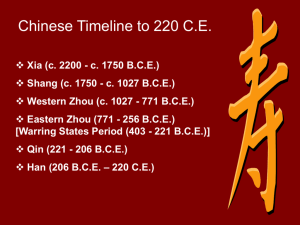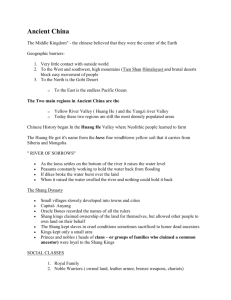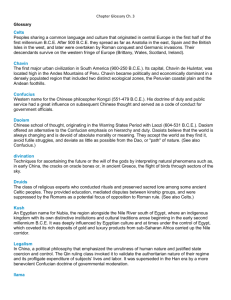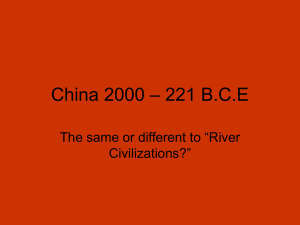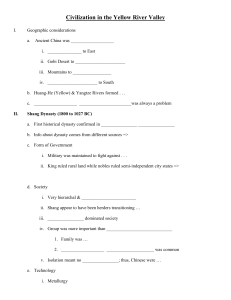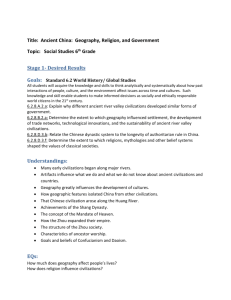File - Ray-Pec AP World History
advertisement
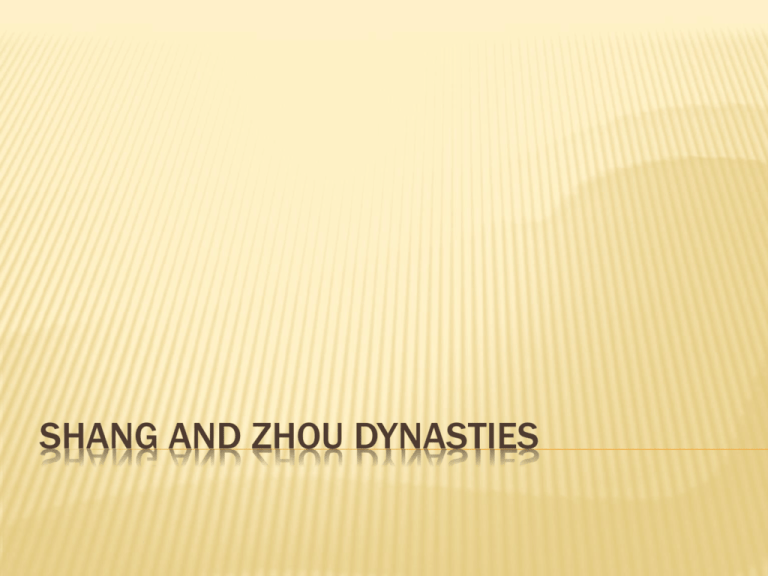
SHANG AND ZHOU DYNASTIES CHINA Civilization Empire Dynastic History Mongols Republic Communism Shang Zhou Qin Han Sui Tang Song Yuan Ming Qing FOUNDATION ACCORDING TO LEGEND Series of rulers Fu Xi -> First domesticated animals and started family life Shen Nang -> Divine Farmer Bent wood for plows Taught people how to farm Huang Di (Yellow Emperor) Created bow and arrow Created writing FOUNDATION ACCORDING TO LEGEND Should we take this literally? (No) This is an attempt for them to explain place in the world Explain their civilization Also, explains characteristics of Chinese Civilization Interaction between nomadic and agricultural peoples Importance of the family as the basic unit of Chinese life Development of a unique system of writing AGRICULTURAL COMMUNITIES (During Neolithic Era) Villages along Yellow River Yangshao and Longshan Differentiated by their pottery Other villages along Yangtze River Cultivation of rice Both developed simultaneously Will develop into civilization NON AGRICULTURAL COMMUNITIES First we need to understand the geography OK….. Arable land Located around Yellow and Yangtze Rivers Food producing areas Only 12% of Chinese land is arable (23% of United States is) They will develop an isolated feel to the outside world. Why do all of the people live in the East? REST OF CHINA: ARID Sea: Not a huge threat Haven for pirates and occasional monsoons Frontier Source of fear/concern They do not have agriculture They are very skilled in warfare DEVELOPMENT OF CIVILIZATION Xia is the first civ Develops out of agricultural communities Shang is the second dynasty POLITICAL ORGANIZATION Agriculture Aristocrats were ruling class Main occupation: making war Horse How did they get them? drawn Chariots Interaction with neighboring regions? Did the Shang migrate into China? Technology led to their establishment of control POLITICAL STRUCTURE King (Transcendent Importance) Central bureaucracy Chieftains controlled parts of kingdom And were in charge of war RELIGION Had a clear sense of life and afterlife Life is not viewed as terrible like India Sacrifices Veneration of ancestors SOCIAL STRUCTURE Shang: Classes developing Peasants Not everyone had land (poorer worked on richer people’s lands) Government officials Some slaves (criminals or POWs), merchants, and artisans (known for bronze making) 1045-221 BCE THE ZHOU DYNASTY RISE OF ZHOU Zhou 800 years (longest in Chinese history) One capital in middle Another in East POLITICAL STRUCTURE Adopted a lot from Shang Divided kingdom into territories Governed by officials appointed by king Hereditary Supposedly always under king’s authority Expanded Also Bureaucracy had ministries for rites, education, law, and public works POLITICAL STRUCTURE CONT’D Mandate of Heaven Concept of heaven: Not a deity, just a part of nature Generally benevolent Not beyond human understanding Heaven maintained order in the universe through the Zhou King King Will is a representation of heaven, NOT a divine being continue to be used throughout Chinese history POLITICAL STRUCTURE CONT’D Mandate of Heaven King is chosen for virtue and talent Was King also responsible for appeasing gods In supposed to be compassionate With sacrifices to protect people from disaster and famine theory, could be replaced POLITICAL STRUCTURE CONT’D 500s BCE: Decline of central government starts Local kingdoms assert more power Become rivalries with each other Local leaders have become hereditary POLITICAL STRUCTURE CONT’D Local Assertion of Power Local rulers regulate the economy Want more power and need money for an expanding army Uniform tax Government monopoly on commodities (mostly salt and iron) ECONOMY Land ownership (like Shang) Rich own it Poor work it But, it was better for the poor Well field system ECONOMY CONT’D Merchants in cities Under lord Property of the lord (could be sold or traded) ECONOMY CONT’D Major growth in later period 500s – 300s Major water control projects Some still in use today Agriculture improvements Plows capable of plowing deeper Natural fertilizer Idea of leaving fields unused to replenish Rice takes over as main staple ECONOMY CONT’D As agriculture goes up Population goes up Commerce increases Trade increases Wealth will begin to replace hereditary birth as the source of power and influence ECONOMY CONT’D Evidence of silk road in 400s BCE Movement toward a money economy Seashells Coins Most with hole in them used barter Even rent and taxes often paid in grain RELIGION Legalism Confucianism Daoism These are not mutually exclusive CONFUCIUS Confucian qualities Ren – benevolence (kindness) Li – propriety (courtesy) Xiao – filial piety (respect family/ancestors) Good leaders would bring order and inspire the population Major influence on Chinese thought His ideas are broad and lend themselves to interpretation DAOISM Laozi – founder of Daoism His life is shrouded in mystery Criticized Confucian thought Introspection, reflection, nature Don’t try to solve problems that have no solution DAOISM The Dao – the “way”, cosmic force and source of all creation Daodejing – book of Daoist belief Disengage from the world Less government Ideally tiny self-sufficient communities
